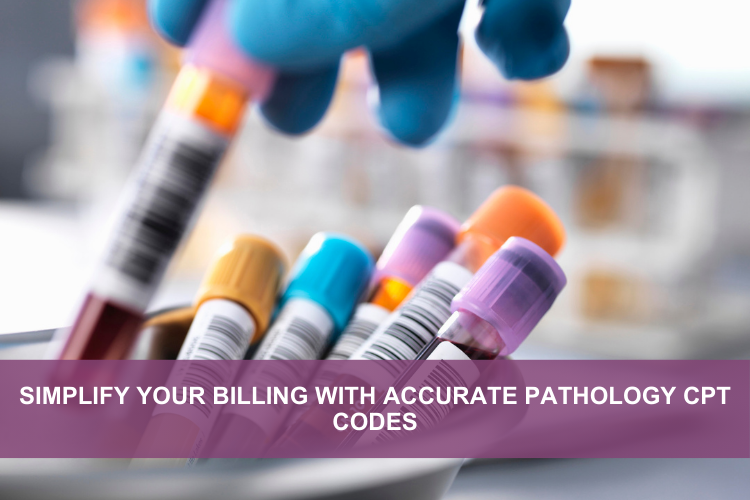Pathology CPT codes are the foundation of accurate billing in pathology practices. These codes classify and describe medical, surgical, and diagnostic procedures performed by pathologists, ensuring proper reimbursement and compliance. However, using these codes correctly can be a challenge, and even small errors can lead to revenue loss, claim denials, and compliance risks.
In this guide, we will explore the common challenges and mistakes in using pathology CPT codes, provide actionable billing tips, and review commonly used codes like 88312 CPT code and 81408 CPT code. By the end, you’ll have a comprehensive understanding of how to optimize your pathology billing practices while avoiding costly errors.
Understanding Pathology CPT Code Ranges
Pathology CPT codes are categorized into various ranges, each representing a specific type of pathology service. These codes are essential for accurate billing and documentation. Below is a breakdown of key pathology CPT code categories and examples to help you understand their application.
CPT Code Ranges and Their Applications
| Category | CPT Code Range | Examples | Application |
| Surgical Pathology | 88300–88399 | 88312, 88304, 88321 | Used for histological examinations, biopsies, and tissue analysis. |
| Cytopathology | 88104–88199 | 88108, 88172, 88177 | Includes services like cytological smears and fluid analysis. |
| Molecular Pathology | 81200–81479 | 81408, 81479 | Covers advanced tests like DNA analysis and molecular diagnostic procedures. |
| Special Stains | 88312–88319 | 88312, 88313 | Applied for histochemical staining with interpretation. |
Commonly Used Pathology CPT Codes
Let’s dive deeper into some frequently used CPT codes:
- 88312 CPT Code
- Description: Special stain for microorganisms like Gram or acid-fast stains, including interpretation.
- Application: Often used for diagnosing infections in tissue samples.
- 88108 CPT Code
- Description: Cytopathology smear, each additional source.
- Application: Typically used in liquid-based cytology for Pap smear testing.
- 81408 CPT Code
- Description: Molecular pathology procedure, Level 9, typically high-complexity genetic analysis.
- Application: Used for advanced diagnostic procedures, such as tumor profiling.
Why Understanding Code Ranges Matters
- Improves Accuracy: Knowing the correct CPT code range ensures that services are billed correctly, reducing coding mistakes and claim denials.
- Enhances Compliance: Proper usage aligns with payer requirements, avoiding audits and penalties.
- Boosts Reimbursement: Accurate coding increases the likelihood of full reimbursements and minimizes revenue delays.
Common Mistakes in Using Pathology CPT Codes
Mistakes in pathology CPT coding can disrupt revenue cycles, lead to compliance issues, and create administrative burdens. Below, we’ll explore the most common errors and their impact on billing efficiency.
Top Common Mistakes in Pathology CPT Coding
| Mistake | Description | Impact |
| Incorrect Code Selection | Using the wrong CPT code for a procedure or test. | Results in claim denials or underpayments. |
| Unbundling Codes | Billing individual components of a procedure instead of using a bundled code. | Can lead to compliance risks and overbilling. |
| Upcoding | Reporting a higher-level code than the service performed. | Triggers audits and penalties. |
| Incomplete Documentation | Failing to provide detailed reports that support the CPT code billed. | Delays reimbursements or causes denials. |
| Payer-Specific Coding Errors | Neglecting payer-specific requirements for certain services or procedures. | Causes claim rejections or reduced payments. |
Examples of Mistakes in Specific Pathology Codes
- Incorrect Use of 88312 CPT Code
- Mistake: Reporting the code for routine stains rather than special stains (e.g., Gram or acid-fast).
- Impact: Causes revenue delays due to incorrect billing for services not performed.
- Unbundling with Molecular Pathology Codes
- Mistake: Separately billing components of a genetic test instead of using a comprehensive molecular pathology code like 81408 CPT code.
- Impact: Risks overbilling and payer disputes.
- Upcoding Cytopathology Codes
- Mistake: Using 88108 CPT code for high-complexity smears when simpler procedures were performed.
- Impact: Triggers payer audits and compliance risks.
Impact of These Mistakes
| Issue | Result |
| Claim Denials | Errors led to rejected claims, delaying reimbursements. |
| Revenue Loss | Mistakes reduce the likelihood of full payments, impacting cash flow. |
| Increased Administrative Costs | More resources are required to rework denied or rejected claims. |
| Compliance Risks | Incorrect coding raises red flags for audits and potential penalties. |
Guidelines for Accurate Billing in Pathology
Accurate billing is the cornerstone of efficient pathology practice management. By following proven billing best practices, you can minimize errors, avoid claim denials, and ensure timely reimbursements. Here’s how to achieve accuracy and compliance in pathology billing.
1. Stay Updated with CPT and ICD Code Changes
- Medical coding updates regularly, and staying informed about revisions in CPT codes and ICD codes is crucial.
- Use reliable coding resources and subscribe to updates from coding authorities like the AMA and CMS.
2. Maintain Comprehensive Documentation
- Ensure that every service provided is backed by thorough and accurate documentation.
- Documentation should detail the medical necessity and procedures performed.
3. Conduct Regular Training for Staff
- Schedule periodic training for your billing and coding team to keep them updated on pathology-specific coding requirements.
- Include payer-specific guidelines in training to address unique rules from different insurers.
4. Use Technology to Automate Billing Processes
- Implement billing software that checks for errors in CPT codes, verifies patient eligibility, and ensures compliance with payer guidelines.
- Utilize automated denial management tools to track and resolve issues faster.
5. Implement Pre-Submission Claim Audits
- Review claims before submission to identify common issues like incorrect code selection or incomplete documentation.
- Establish a checklist for your team to verify the accuracy of each claim.
6. Prioritize Denial Management
- Track denied claims to identify patterns and root causes of errors.
- Create a proactive strategy for addressing recurring issues, such as errors with molecular pathology codes like 81408 CPT code.
Examples of Commonly Used Pathology CPT Codes
Understanding how to properly use pathology CPT codes is essential for accurate billing and timely reimbursements. Below are some commonly used codes, their descriptions, and best practices for their application in pathology billing.
Frequently Used Pathology CPT Codes
| CPT Code | Description | Application | Best Practices |
| 88312 | Special stain for microorganisms (e.g., Gram or acid-fast), including interpretation. | Used for identifying infections in tissue samples. | Ensure the code is used only for specialized stains and not routine histological stains. |
| 88108 | Cytopathology smear, each additional source. | Commonly used in liquid-based cytology for Pap smear testing. | Confirm the number of smear sources to avoid underbilling or overbilling. |
| 81408 | Molecular pathology procedure, Level 9. | Applied for high-complexity genetic analysis, such as tumor profiling or DNA sequencing. | Ensure detailed documentation supports the complexity level to justify the use of this code. |
| 88304 | Level III surgical pathology, gross and microscopic examination. | Typically used for small biopsies or skin samples. | Match the pathology report with the correct level of surgical pathology to avoid upcoding. |
| 88342 | Immunohistochemistry (IHC) for tumor analysis or other diagnostic purposes. | Frequently used in cancer diagnostics to identify specific markers. | Only use this code if the test was specifically requested and documented in the patient’s records. |
Case Scenarios for Pathology CPT Code Usage
- Scenario 1: Identifying Infections in Tissue Samples
- Procedure: Special stains for microorganisms are performed on a lung tissue biopsy.
- Correct Code: 88312
- Tip: Document the specific type of stain used (e.g., Gram or acid-fast) to avoid coding errors.
- Scenario 2: High-Complexity Genetic Testing
- Procedure: Tumor DNA sequencing is conducted for a cancer patient.
- Correct Code: 81408
- Tip: Ensure the complexity of the procedure aligns with Level 9 molecular pathology requirements.
- Scenario 3: Cytopathology in Routine Screening
- Procedure: Pap smear testing using liquid-based cytology.
- Correct Code: 88108
- Tip: Track the number of additional smear sources to ensure accurate billing.
Common Pitfalls and Solutions
| Pitfall | Solution |
| Using incorrect CPT codes for procedures | Cross-check coding guidelines and payer requirements before claim submission. |
| Missing or incomplete documentation | Collaborate with pathologists to ensure detailed reports that justify the billed services. |
| Upcoding or unbundling | Audit claims before submission to identify coding errors that could result in denials or compliance risks. |
Tips for Maximizing Reimbursement Strategies
Maximizing reimbursements in pathology billing requires a strategic approach to minimize errors and optimize processes. Below are practical tips that can help pathology practices enhance their financial performance and reduce claim denials.
1. Adopt Proactive Denial Management
- Identify the most common causes of denials, such as incorrect CPT codes, incomplete documentation, or payer-specific errors.
- Use analytics tools to track denial patterns and implement corrective actions.
- Pro Tip: Prioritize high-value claims for immediate resolution to reduce revenue loss.
2. Verify Insurance and Eligibility Upfront
- Confirm patient coverage details before services are rendered.
- Use electronic verification systems to reduce errors and prevent claim rejections due to eligibility issues.
- Example: Verify coverage for procedures like 88108 CPT code to ensure they are included under the patient’s plan.
3. Streamline Documentation Practices
- Ensure detailed and accurate reports are provided for each procedure, such as molecular tests (81408 CPT code) or special stains (88312 CPT code).
- Conduct regular audits of documentation to align with payer requirements.
- Pro Tip: Use templates for pathology reports to maintain consistency and avoid missing critical details.
4. Leverage Technology for Automated Billing
- Use billing software to automate processes, reduce manual errors, and validate coding.
- Implement denial tracking tools to ensure faster resolutions.
- Example: Automated systems can check for unbundling errors in immunohistochemistry codes (88342 CPT code) before claim submission.
5. Train Staff on Coding Updates
- Conduct periodic training sessions for your billing and coding team on the latest CPT codes, ICD codes, and payer-specific rules.
- Ensure staff understands how to use complex codes like 81408 accurately to justify high-complexity procedures.
- Pro Tip: Include examples of coding mistakes in training to reinforce best practices.
6. Optimize Payer Contracts
- Review and negotiate contracts with payers to secure favorable reimbursement rates.
- Ensure payers include all essential pathology services within their covered procedures.
- Pro Tip: Use historical claim data to highlight underpayments and negotiate adjustments.
7. Perform Regular Billing Audits
- Conduct periodic reviews of claims to identify trends in denials or underpayments.
- Focus on high-volume codes like 88312 and 88108 to ensure accuracy and compliance.
- Example: Audits can reveal coding issues in molecular pathology tests that might otherwise go unnoticed.
Conclusion
Accurate and efficient pathology billing is essential for maintaining a strong revenue cycle and avoiding unnecessary financial setbacks. By understanding the correct usage of CPT codes, avoiding common coding mistakes, and adhering to billing best practices, pathology practices can optimize their operations and ensure compliance with payer requirements.
- Proper use of pathology CPT codes like 88312, 88108, and 81408 prevents revenue loss and minimizes claim denials.
- Staying updated with coding changes and maintaining documentation accuracy are critical for ensuring timely reimbursements.
- Implementing technology-driven solutions and proactive reimbursement strategies streamlines the billing process and improves cash flow.
By following the guidelines and tips provided in this guide, you can build a robust billing framework that not only improves financial performance but also enhances patient trust and operational efficiency.
At A2Z Medical Billing Services, we specialize in helping pathology practices simplify their billing processes and maximize reimbursements. Whether it’s ensuring accurate coding, managing denials, or conducting audits, our experts are here to assist you every step of the way.



